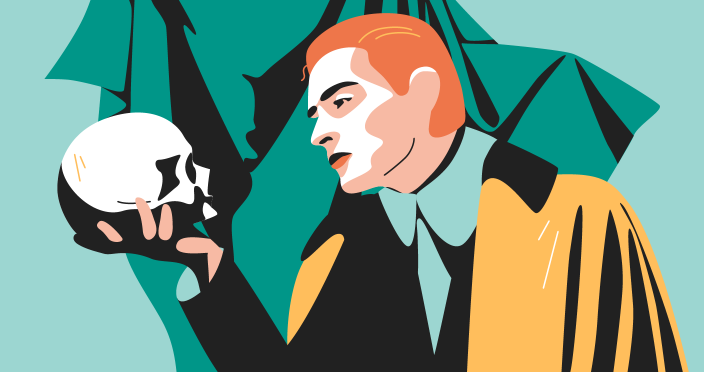Symbols in Hamlet play a crucial role in conveying the sophisticated themes of Shakespeare’s iconic tragedy. The unweeded gardens, the Yorick’s skull, Ophelia’s flowers, and other elements are used in the play to refer to ever-present motifs of decay, the victory of evil, etc. As noted by Harold Bloom in his book Shakespeare: The Invention of the Human, the recurring symbolism in Hamlet opens up the complexities of human consciousness and the existential dilemmas that define the play.
In this article prepared by IvyPanda experts, you’ll discover the critical pieces of Hamlet imagery— Yorick’s skull, the ghost, unweeded gardens, Ophelia’s flowers, and the mousetrap —as well as the costumes’ symbolism in Hamlet. This analysis will help you understand Hamlet’s characters and the underlying meaning in certain scenes. Explore how Shakespeare deepens the audience’s perception of mortality, madness, and revenge to reflect the psychological dilemmas of the characters, particularly Prince Hamlet himself.
💀 Hamlet Symbolism: the Key Elements
- Yorick’s skull: highlights the theme of death and the idea of equality of people in the afterlife.
- The ghost: symbolizes the victory of evil.
- Unweeded gardens: contribute to the themes of darkness, decay, and death.
- Ophelia’s flowers: represent her descent into madness.
- Costumes: the changes to the Hamlet’s wardrobe highlight his inner transformations.
- The Mousetrap: the play used by Hamlet as a tool to reveal Claudius’s guilt.
🪦 Yorick’s Skull in Hamlet

Yorick’s skull and the whole graveyard scene in Hamlet are crucial to learning more about the protagonist himself. These elements appear in act 5, scene 1, after Ophelia’s death.
In this scene, two gravediggers provide some comic relief while singing and discussing Ophelia’s death. Then, Hamlet and Horatio approach. They discuss death and Hamlet makes the well-known “Alas poor Yorick” speech:
Alas, poor Yorick! I knew him, Horatio: a fellow
Hamlet, Hamlet, Act V, Scene 1
of infinite jest, of most excellent fancy: he hath
borne me on his back a thousand times; and now, how
abhorred in my imagination it is! my gorge rims at
it. Here hung those lips that I have kissed I know
not how oft. Where be your gibes now? your
gambols? your songs? your flashes of merriment,
that were wont to set the table on a roar? Not one
now, to mock your own grinning? quite chap-fallen?
Now get you to my lady’s chamber, and tell her, let
her paint an inch thick, to this favour she must
come; make her laugh at that.
The “Alas poor Yorick” meaning lies in the themes of death and equality. Hamlet is confronting mortality and the notion that everyone is equal in the afterlife.
📌 Who is Yorick?
From the start of his speech, Hamlet reveals that Yorick was a funny man that he knew well while he was alive. He was the court jester of King Hamlet. This is why Prince is so familiar with Yorick, as he knew him in childhood.
Why Was the Skull Thought-provoking for Hamlet?
A skull is a symbol of death and decay. However, this scene is also a moment of reflection for Hamlet. He contemplates the way death makes us all equals, regardless of our status in life. He compares Yorick to Alexander the Great, saying both of their skulls look the same in death.
Hamlet is reflecting on childhood, his parents, and a matter of life and death. He looks back fondly on his childhood memories of Yorick, laughing at his jokes and playing with him. Hamlet has had to face death in many forms in this play: the ghost of his father, killing Polonius, and thoughts of killing others. He is now at the graveyard, unaware that he is about to witness the burial of his potential wife, Ophelia.
Seeing Yorick’s skull is the first time Hamlet confronts death in such a direct way. Even the jester, someone so full of life, ended up in this graveyard. Prince is coming to terms with human mortality that has tormented him throughout the play. He goes from seeing it as an abstract concept to facing it directly.
📌 How did Yorick die?
Now, the cause of Yorick’s death is unclear in the play. This could be to highlight the notion that regardless of how we die, death is inevitable for everyone, and we all end up in the same place.
What Does the Gravedigger Scene Reveal about Hamlet?
The gravedigger scene is a turning point for Prince. It forces him to confront the suffering he has endured over the topic of death in a more concrete way. He begins to see death as inevitable, final, and removing of the status one possessed in life.
A graveyard is a place where all are equal as death destroys differences between people and their social statuses. Thus, Hamlet begins to accept it as humanity’s shared ending.
The gravediggers are of lower social status than other characters, so they provide comic relief and a new perspective on the story. As Horatio mentions, people working in the graveyards become insensitive to the positions and social class of the dead. This way, their jokes emphasize that status does not matter.
👻 The Ghost in Hamlet

The ghost in William Shakespeare’s Hamlet remains one of the mysteries of English literature. Readers may think it is simply a representation of the main character’s madness. But here’s the thing: Hamlet is not the only person that sees the ghost. So it may not be immediately clear what this character represents.
Hamlet and the ghost appear in several scenes together. Below is a description of each time the ghost appears throughout the play.
Act 1 Scene 1
Two guards, Bernardo and Marcellus, tell Horatio that they’ve seen the ghost of the late King Hamlet. Afterward, the three men observe how the spirit appears and quickly disappears before them. The men decide to find the King’s son, Prince Hamlet, to see if the ghost will speak to him.
Shakespeare seems to have placed the ghost in this scene to introduce the character and alert the other characters to impending danger in Denmark.
Act 1 Scenes 4-5
In this part of the play, Hamlet encounters the ghost and speaks to him. The spirit claims to be his father and that Claudius murdered him in his sleep. He attempts to convince Hamlet to seek revenge for his murder.
Prince decides to obey the request for revenge, and this sends Hamlet into a state of feigned madness through the rest of the play. The ghost disappears at daybreak, and Prince sets out to avenge his father’s death.
The function of the ghost in this scene is to send Hamlet to seek revenge and begin acting as if he were mad. This abruptly changes the way he interacts with other characters. It also causes everyone, as well as the reader, to question his sanity.
Act 3 Scene 4
Here, Hamlet is arguing with his mother, Gertrude. As he shouts at her about her marriage to the evil Claudius, the ghost of King Hamlet appears again. He reminds Prince of his goal and promise.
Up until this point, Hamlet claims he had been faking insanity. He uses this incident to tell his mother he is not mad. However, the fact that Gertrude cannot see the ghost points toward the fact that he may be insane after all.
Now, you may be wondering, what does the ghost symbolize in Hamlet? Below is a list of common questions to help you analyze the symbolism of this character.
What Does the Ghost in Hamlet Represent?
The ghost appearing as Hamlet’s father brings up haunting memories for Prince surrounding his past. This demonstrates that he is haunted by the memory and death of his father. He is also haunted by his mother’s marriage to Claudius and the troubles ahead for Denmark.
The ghost symbolizes that the evil won this fight. The noble King has died, and the wicked Claudius has become the new ruler. This transition of power from good to evil provides foreshadowing that the nation may be in danger. The ghost not only seeks revenge but hopes to save Denmark from a corrupt leader.
The people who can see the ghost are Horatio, the guards, and Hamlet. Yet only Prince can talk to him. This is one of the most crucial bits of evidence toward the theory that the ghost is Hamlet’s fantasy rather than a real apparition.
Besides, the ghost resembles Hamlet in that the two are both pale and have similar features. They also have a manner of speaking. This could be due to their relationship as father and son. It may also allude to the idea that the ghost is merely a figment of Hamlet’s imagination.
🥀 Hamlet’s Unweeded Gardens

The symbolism in William Shakespeare’s Hamlet affects every aspect of the play, including the scenery. Throughout the play, readers will notice imagery of unweeded gardens. Characters bring up the disgusting state of these gardens repeatedly. Taking a deeper look, you will notice that there is more to this imagery than just untamed nature.
As it turns out, characters use the decaying gardens as a symbol for many topics that displease them. This symbolism occurs consistently throughout the entire play, but one of the more memorable instances is Claudius’s soliloquy stating:
O my offense is rank. It smells to heaven.
Hamlet, Claudius, Act III, Scene 3
No doubt about it, the line reveals Claudius’s moral corruption. He admits that he is guilty of killing the king to take the throne. He feels sinful and unforgivable for this act he has committed.
Hamlet is all about death, confronting mortality, and coming to terms with the declining state of Denmark, among other dark topics. Naturally, Shakespeare wove these themes into the scenery itself. So, without further ado, let’s jump into a Hamlet unweeded garden analysis.
Nature Imagery in Hamlet
Simply put, the gardens are plagued with disease and rot. For this reason, seeds in this garden cannot produce anything good. Hamlet describes the garden as rank and gross in nature, meaning to describe his feelings toward the relationship between his mother and his uncle.
The weeds and flowers in the garden are unkept, sickly, and give off a horrible odor. These negative descriptions are a way for characters to state how they feel about their circumstances. That’s why treader learns of the state of the gardens mostly through dialogues. Characters comment on the horrible smell or appearance to express disgust for certain circumstances, events, or other people in the play.
The gardens contribute to the themes of darkness, decay, and death that are present in Hamlet. Images of rotting weeds overtake nature, something that should be beautiful and pure. The gardens contribute to the kingdom’s description. It was once lively and well but has been corrupted and poisoned by an invasive force.
Unweeded Gardens as a Symbol of Hamlet
The gardens are the symbol of the “rotten” state of affairs in Denmark. The nation is facing corruption and decline because of Claudius. Since he gained the throne by murdering his brother, he has corrupted the state of Denmark. Similarly, the weeds seem to be poisoning the garden in the play.
By now, you probably know that Hamlet is an indecisive character. The weeds also represent inaction, since no one has come to tend to them. This alludes to the fact that Hamlet’s indifference and indecision have contributed to negative developments in his life.
What’s more, Prince even commands his mother not to fertilize the weeds with compost, as it leads to only makes them stronger. This is his way of asking his mother to end her affair with Claudius. This brings us back to Hamlet’s consistent use of the gardens to express disgust for this relationship.
Unweeded Gardens: Biblical Allusions
The gross and rank state of the garden also alludes to the garden of Eden. Both kingdoms have been taken over by means of poison and murder. Hamlet compares the world to a garden: since it has been neglected, it has fallen into a state of chaos. This could also be a way to describe Prince’s life.
The fact that the King was killed in the garden alludes to the biblical story as well. The garden of Eden reference grows more apparent when you realize that Old Hamlet was also poisoned. Both stories feature references to a snake, as the ghost says:
The serpent that did sting thy Fathers life,
Hamlet, Ghost, Act I, Scene 5
Now wears his crown.
🧥 Symbolism of Costumes in Hamlet

Every detail in Hamlet contains symbolism, and costumes are no exception. The changes to the protagonist’s wardrobe are an outward representation of how he is transforming mentally and emotionally throughout the play. The most important items are the dark blue cloak and the black clothes he wears.
Hamlet’s costume description not only mentions the colors but also indicates the state of cleanliness. The character’s descent into madness is represented by a more disheveled, dirty, and messy appearance as well. Taking a look at these factors will help the reader understand Hamlet’s costume symbolism that fills this play.
Hamlet’s Dark Blue Cloak Significance
Prince wears a dark blue cloak at the beginning of the play. It symbolizes mourning for his dead father. He continues wearing it throughout the play, which irritates his mother. Finally, she asks him to stop wearing it. His response in Act 1, Scene 2 is this memorable quote:
Tis not alone my inky cloak, good mother,
Hamlet, Hamlet, Act I, Scene 2
Nor customary suits of solemn black,
Nor windy suspiration of forced breath,
No, nor the fruitful river in the eye,
Nor the dejected ‘havior of the visage,
Together with all forms, moods, shapes of grief,
That can denote me truly: these indeed seem,
For they are actions that a man might play:
But I have that within which passeth show;
These but the trappings and the suits of woe.
Hamlet explains that his clothes only represent a small part of his grief. While some people may use costumes to pretend they are grieving, his items do not begin to convey the amount of pain he feels.
Hamlet’s Black Costumes Significance
After Hamlet’s mother asks him to stop mourning, he proceeds to wear dark, black clothing. This change indicates his anger and pain. He plans to avenge his father’s death and does not plan to stop his mourning until he does so.
What’s more, Hamlet wants the people around him to know that he isn’t done yet. He seeks revenge and isn’t afraid to show his true emotions, unlike other people at court. His clothes are also a visual reminder to the reader and the other characters that Prince knows the truth about his father’s death. He sees Claudius and his mother as sinners.
Hamlet’s Motives as Told by Costumes
Hamlet’s clothing changes also reflect his efforts to fake his insanity. Ophelia thinks he’s mad due to his appearance. In Act 2, Scene 1, she mentions this to Polonius in this quote:
My lord, as I was sewing in my closet,
Hamlet, Ophelia, Act II, Scene 1
Lord Hamlet, with his doublet all unbrac’d,
No hat upon his head, his stockings foul’d,
Ungart’ red, and down-gyved to his ankle;
Pale as his shirt, his knees knocking each other,
And with a look so piteous in purport
As if he had been loosed out of hell
To speak of horrors- he comes before me.
Here, she states that she has become afraid of Hamlet due to his strange appearance. Ophelia indicates fearing that he has gone mad due to his love for her. However, Hamlet later claims that he faked this madness. Regardless of whether it was real or not, this transformation was due to the pain Hamlet feels.
🌺 Ophelia’s Flowers as a Symbol in Hamlet

Ophelia’s flowers are an excellent example of how Shakespeare brought so much symbolism to even the smallest elements of the play. They represent her descent into madness and also allow her to make her opinion of the other characters known.
As it turns out, Ophelia’s flower speech in Act 4 is not only a representation of her madness. Each flower she brings up also carries a message for the character who receives it. In Act 4, Scene 5, she offers flowers and describes what they symbolize in this memorable quote:
There’s fennel for you, and columbines: there’s rue
Hamlet, Ophelia, Act IV, Scene 5
for you; and here’s some for me: we may call it
herb-grace o’ Sundays: O you must wear your rue with
a difference. There’s a daisy: I would give you
some violets, but they withered all when my father
died: they say he made a good end…
For bonny sweet Robin is all my joy.
What’s more, in Acts 4 and 5, readers will continue to notice Ophelia paired with such imagery. Analyzing her flowers will provide a deeper understanding of the character, as well as the play itself.
Ophelia’s Flowers Meaning
The flowers are a signal of Ophelia’s descent into madness. They reveal her inner turmoil due to the grief and pain she feels. Since Hamlet killed her father, the feeling of betrayal has overcome her, and she never truly recovers. Thus, they also represent how Prince affected the people around him.
Each flower in Ophelia’s speech is a symbol of some sort. This is her final effort to communicate how she feels about the people in her life, so it is one of her most powerful moments.
Hare the flowers Ophelia offers and their meanings:
- Fennels typically signify the feeling of sorrow, but it can also represent adultery.
- Ophelia offers fennel to King Claudius, which highlights his unfaithfulness.
- Rues are usually representative of feelings of bitterness, and can also be linked to dishonesty or adultery. “Rue” is also another word for regret, so this could be an additional sentiment of Ophelia’s repentance and sorrow.
- Ophelia offers one to Queen Gertrude and then states that she will keep some for herself.
- Violets are a symbol of faithfulness and fidelity in this case. They carry a particularly potent meaning, as Ophelia claims they all withered when her father died.
- Ophelia mentions that she would have brought violets if they hadn’t withered when her father died. This sends the message that the purity in Denmark was corrupted at the time of his death.
- Columbines are known as the flower of deception involving love or lust. This could represent unfaithfulness in marriage.
- Ophelia offers it to King Claudius as another comment on his adulterous actions.
- Daisies represent innocence.
- Ophelia picks up a daisy, and then sets it back down, offering it to no one. This could be a comment on the fact that the innocence in Denmark, and in her own life, has vanished.
- Rosemary and pansies – Ophelia claims that both of these flowers symbolize remembrance and thoughts.
- Ophelia offers them to Laertes. Rosemary and pansies are among the flowers with the most positive symbolism attached to them. Ophelia presents Laertes with them as a sign of love and remembrance. Even in her unbalanced state of mind, she is showing love for her brother. This tells us that the message offered by each flower is intentional and specific to its recipient.
The inner meanings of these flowers will give the reader a clue as to how Ophelia feels about these characters. They may also provide insight as to which one she may want to give Hamlet. She may attempt to give him rosemary as a sign of remembrance and love, assuming she is still unaware that he killed her father.
Which Flowers Did Ophelia Die with?
Ophelia died with many extravagant flowers around her neck and body. She drowned herself in a brook in Act 4, Scene 7, while wearing the garlands of “crow-flowers, nettles, daisies, and long purples.”
Ophelia was buried with a very plain ceremony, which was meant to indicate that she died by suicide. The grave diggers speculate that the fact she is being buried in the churchyard meant she must have been wealthy.
Laertes argues with the priest after he says he will not perform more than the minimum rites for Ophelia. Queen Gertrude throws flowers on her grave, saying she wishes they could have been flowers for her wedding to Hamlet.
🔪 The Murder of Gonzago in Hamlet: Symbolism

Shakespeare’s Hamlet includes countless examples of symbolism, including the play within a play. It’s called The Murder of Gonzago, and Hamlet nicknames it, The Mousetrap.
To Hamlet, this play is a tool he can use to reveal Claudius’s guilt regarding the death of his father. He insists on directing The Mousetrap because he needs to know the truth. Let’s take a deeper look to learn Shakespeare’s reasoning for including this crucial plot point.
📌 When did the play first appear in Hamlet?
The Murder of Gonzago first appears in Hamlet in act 2, scene 2. This is a key moment for Prince. He is looking for evidence of Claudius’s guilt before following through with the task of avenging his father’s death.
It comes up again in act 3, scene 2. At the start of the scene, Hamlet instructs the players before their performance. Then, he meets with Horatio, speaking with him about the need to keep an eye on Claudius as he watches the play.
📌 What’s the Play within the Play about?
The Murder of Gonzago, or The Mousetrap, follows a similar storyline to the recent events in Hamlet’s life. The play has a deliberate repetitive quality, enabling the reader to focus on the main plot point. It works as a tool to draw our attention to the interactions between Hamlet, Claudius, and other characters.
Why Does Hamlet Stage the Play?
Hamlet insists on directing the play to detect whether or not his uncle is guilty of murder. In The Mousetrap, he creates a death scene with all the characteristics of his father’s death. It works as a trap to catch the conscience of Claudius in his reaction to the death scene.
Another key reason Hamlet decides to direct the play is to shame his mother. “Mouse” is Claudius’s pet name for Hamlet’s mother, Gertrude. Hamlet named the play The MouseTrap as it combines this pet name with the obvious “trap” that he is enacting.
Besides the scene with the murder, the play is intended to get a reaction from Gertrude. At one point, Hamlet even asks her how she likes the play. The goal is to force his mother to confess her crime, recall her promise to her late husband, or at least show signs of guilt or shame.
With these two key underlying motivations, the play acts as a symbol of guilt and betrayal. It allows Hamlet to gain clarity regarding Claudius’s guilt, and Claudius to become certain that Hamlet seeks revenge.
What’s the Role of The MouseTrap?
The play is meant to confirm whether Hamlet’s father’s ghost was telling the truth. This is why it is so important to Hamlet to get a reaction from Claudius. He needs to know whether or not to trust the ghost and whether or not to avenge his father’s death.
That’s why Horatio’s presence in the scene is important. He’s the only character Hamlet can trust. He has already told Horatio about the ghost’s revelation and his suspicion that his uncle killed his father. He asks Horatio to keep an eye on Claudius during the play and look for clues that he is guilty.
It turns out, Claudius’s response is all the confirmation Hamlet needs that his uncle killed his father. Right as Lucianus pours poison into the Player King’s ear, Claudius stands up angry and shaken. He exits, along with the rest of the crowd, and Hamlet is happy knowing he can trust the ghost’s revelation and act with confidence as he plots his revenge.
Thanks for reading the article! That’s all we can say about symbolism in Hamlet. For information about other aspects of the play, check the links below.
